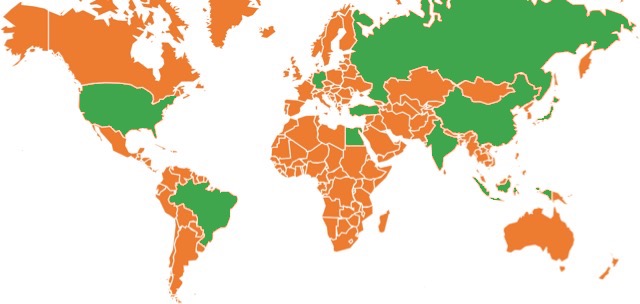The top ten economies in the world by 2030

According to Standard Chartered research, by 2030, seven of the world’s top 10 economies will come from what we now call emerging markets.
Sometimes a little bit of research is all it takes to reset your fixation with short term market fluctuations and pan back to see some longer term trends.
That was certainly the case for me last week when UK multinational bank Standard Chartered produced some interesting research that showed that by 2030, seven of the world’s top 10 economies will come from what we now call developing economies or emerging markets.
Like all forecasts, it is possible to argue with Standard Chartered’s methodology but there is little doubt that it is in the right ball park by predicting that China’s economy will be double that of the United States by 2030, with India also a third bigger than the US.

The top 10 economies in the world in 2030.
Here is the list by Standard Chartered of the top 10 economies ranked by GDP in the year 2030:
1. China: $64.2 trillion
2. India: $46.3 trillion
3. US: $31 trillion
4. Indonesia: $10.1 trillion
5. Turkey: $9.1 trillion
6. Brazil: $8.6 trillion
7. Egypt: $8.2 trillion
8. Russia: $7.9 trillion
9. Japan: $7.2 trillion
10. Germany: $6.9 trillion.
Asia’s emerging markets are looking likely to dominate the future global economy.
Asia, South America and Africa bursting on to the investment map
The rest of the top 10 is also made up of some names that are better known for large populations on low incomes than as global economic superpowers.
Also somewhat surprising is that our close northern neighbour and the world’s biggest Muslim nation, Indonesia, comes in at number four.
Following that are the also unlikely names of Brazil, Egypt and Russia before the more expected superpowers of Japan and Germany.
The really important thing to realise from this research is that the world economy is reshaping itself fairly quickly, producing some changes that require a response from any rational investor trying to maximise long term returns.
Continuation of the BRIC theory
To put it simply, if countries such as China, India, Brazil, Egypt and Russia are on a solid, long term growth path, it only makes sense to invest to take part in that growth.
It is an extension of the BRIC theory first developed by former Goldman Sachs economist and chairman Jim O’Neill back in 2001.

Leaders of the BRICS nations: Brazil, Russia, India, China and South Africa.
Initially the BRIC countries were Brazil, Russia, India and China, but there were many proposed additions along the way including South Africa and Indonesia.
The basic BRIC theory was that investing in the growth of these countries would deliver out-sized returns as the middle classes in these countries expanded rapidly along with their economic output.
Surprising facts
Among some of the surprising forecasts arrived at by Standard Chartered was the fact that the middle class is already on the cusp of becoming the world’s largest demographic group by 2020.
They projected that trend growth for India would accelerate to 7.8% by the 2020s while China’s will moderate to 5% by 2030 reflecting a natural slowdown given that economy’s size.
Asia’s share of global GDP, which rose to 28% last year from 20% in 2010, will likely reach 35% by 2030 – matching the EU and US combined.
“Our long-term growth forecasts are underpinned by one key principle: countries’ share of world GDP should eventually converge with their share of the world’s population, driven by the convergence of per-capita GDP between advanced and emerging economies,’’ said the Standard Chartered report, which was led by economist David Mann.
The Standard Chartered analysts also predicted that middle-class growth driven by urbanisation and education should help counter the effects of the rapid population ageing trend in many economies, including China.
“We continue to expect Asia, led by China, to power global growth. Seven of the top 10 economies in 2030 will likely be current emerging markets. We estimate that India and Indonesia will join China in the top five.”
How to invest to capture the growth
The good news for investors is that it is not terribly difficult to invest for the big changes coming for the world economic league tables.
While some early investors in the BRIC phenomenon tried to invest directly in those economies and many BRIC investment products of varying quality were manufactured and marketed, the results seemed to be better if you simply invested in large stocks in the big, liquid markets such as the US, Europe and Japan.
The large, multinational companies in those markets are already heavily invested in the developing world and will gain revenue and profits as those economies continue to expand.
Big international stocks already in emerging economies
A good recent example is Apple, with the stock going into a sharp retreat due to flagging sales in China.
That shows how intricately linked many of the major US companies already are with the emerging economies.
If the Standard Chartered predictions come to pass, you would expect the big multinationals in Europe and the US to be heavily exposed to the fast growing economies.
That means that a simple ETF (exchange traded fund) that covered the S&P 500 or even the Nasdaq or the total US market would buy appropriate exposure – with the caveat that you will also be getting exposed to currency fluctuations through the US dollar.
It is a similar case for Europe and Japan, although there are sure to be many more complex and potentially better ways to ride the change in the international pecking order.
